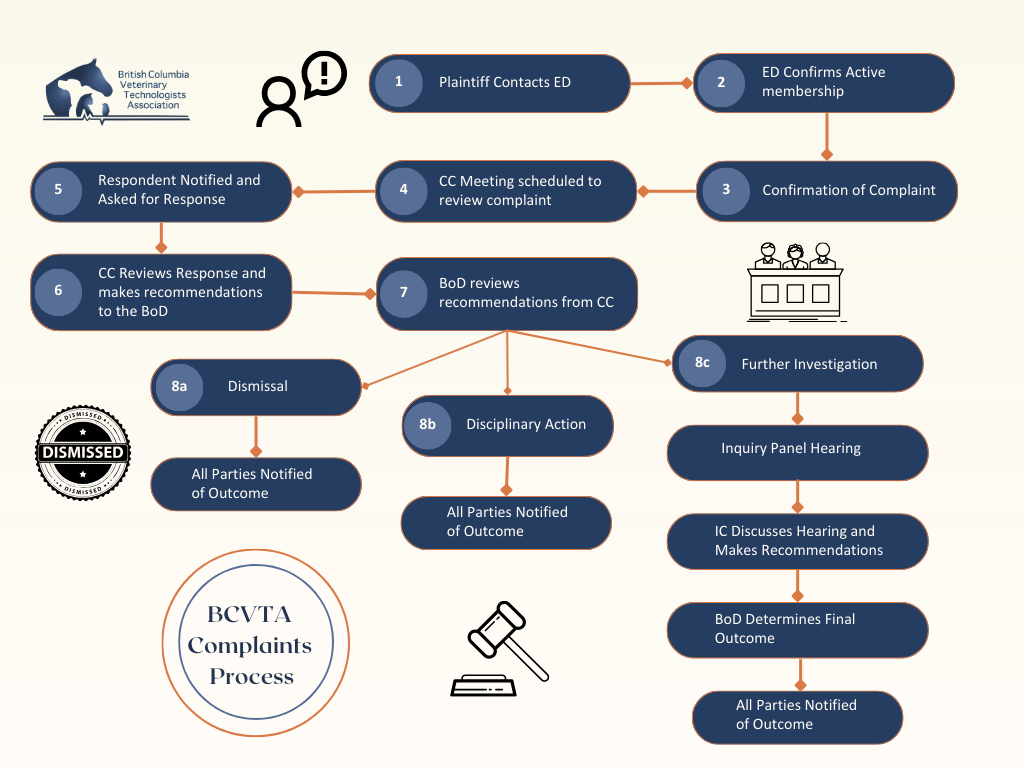
Role of the BCVTA in Complaints
The BCVTA is not a regulator and has no authority to request medical records or confidential information or to intervene in cases involving Doctors of Veterinary Medicine (DVMs) and veterinary practices.
The BCVTA can determine if a member has violated the code of ethics required for membership. If it is determined that this has happened, the BCVTA Board of Directors will determine disciplinary action, which may include:
- Requiring specific continuing education courses.
- Requesting attendance at a Bylaw Seminar.
- In rare cases, suspending membership.
If the complaint is regarding a veterinarian, please proceed to the College of Veterinarians of BC website here.
BCVTA and the Occupational Title Society
The British Columbia Veterinary Technologists Association (BCVTA) operates as an Occupational Title Society under the Societies Act of British Columbia. This designation provides exclusive protection for the title “Registered Veterinary Technologist” (RVT), ensuring that only members of the association can use this title.
To qualify as an RVT, individuals must fulfill the following requirements:
- Graduate from an accredited two-year veterinary technology program or possess an equivalent qualification.
- Successfully pass the Veterinary Technician National Exam.
- Commit to adhering to the National Association of Veterinary Technicians in America (NAVTA) code of ethics.
- Regularly complete continuing education to maintain their membership status.
This framework ensures that anyone using the RVT title has met the stringent standards set by the BCVTA.
If you become aware of an individual using the RVT title who is not a member of the association, please contact us at executivedirector@bcvta.com.
Steps of the Complaints Process
- The Plaintiff (individual submitting the complaint) contacts the BCVTA Executive Director (ED) with a possible complaint.
- The ED confirms that the Respondent (subject of the complaint) is an active member of the BCVTA and provides information on the process to the Plaintiff.
- The ED requests the official complaint from the Plaintiff, to be submitted through Google Forms.
- The Complaints Committee (CC) is informed of the complaint and provided with the details. A meeting is scheduled.
- The CC reviews the complaint and provides confirmation of receipt of the complaint to the Plaintiff and a notice of the complaint to the Respondent.
- The Respondent is notified of the complaint and asked to provide written confirmation by signed letter. They are also given the opportunity to submit a written response to the CC.
- The CC meets again to review the response when received and to determine recommendations for action to the Board of Directors.
- The Board of Directors reviews the recommendations and determines action. This may be dismissal, disciplinary action, or additional review by the Inquiry Committee. Possible outcomes include:
- The complaint is dismissed: A complaint may be dismissed for several reasons, including:
- The Board of Directors determines that the member has not violated the code of conduct and/or requirements of membership
- There is not enough information to clearly determine if the member has violated the code of conduct and/or requirements of membership
- The complaint is medical in nature and is outside of the authority of the BCVTA.
- Disciplinary Action: The Board of Directors determines that the member has violated the code of conduct and requires the member to complete appropriate continuing education. In extreme, but rare cases, the member’s registration is suspended.
- Further investigation: The Board of Directors may determine that more information is needed and refer the complaint to the Inquiry Committee (IC). The IC schedules a meeting to review all information in the complaint and may form an Inquiry Panel (IP, 3 members of the IC) and schedule a hearing within 90 days of the notice being provided.
- The complaint is dismissed: A complaint may be dismissed for several reasons, including:
- During the hearing, the Respondent will be given an opportunity to provide any additional details, including any additional evidence or witnesses desired. The IP will ask clarifying questions to get the complete picture of the event or concern.
- The Inquiry Committee will meet again to determine the outcome.
- All parties are notified of the outcome.
